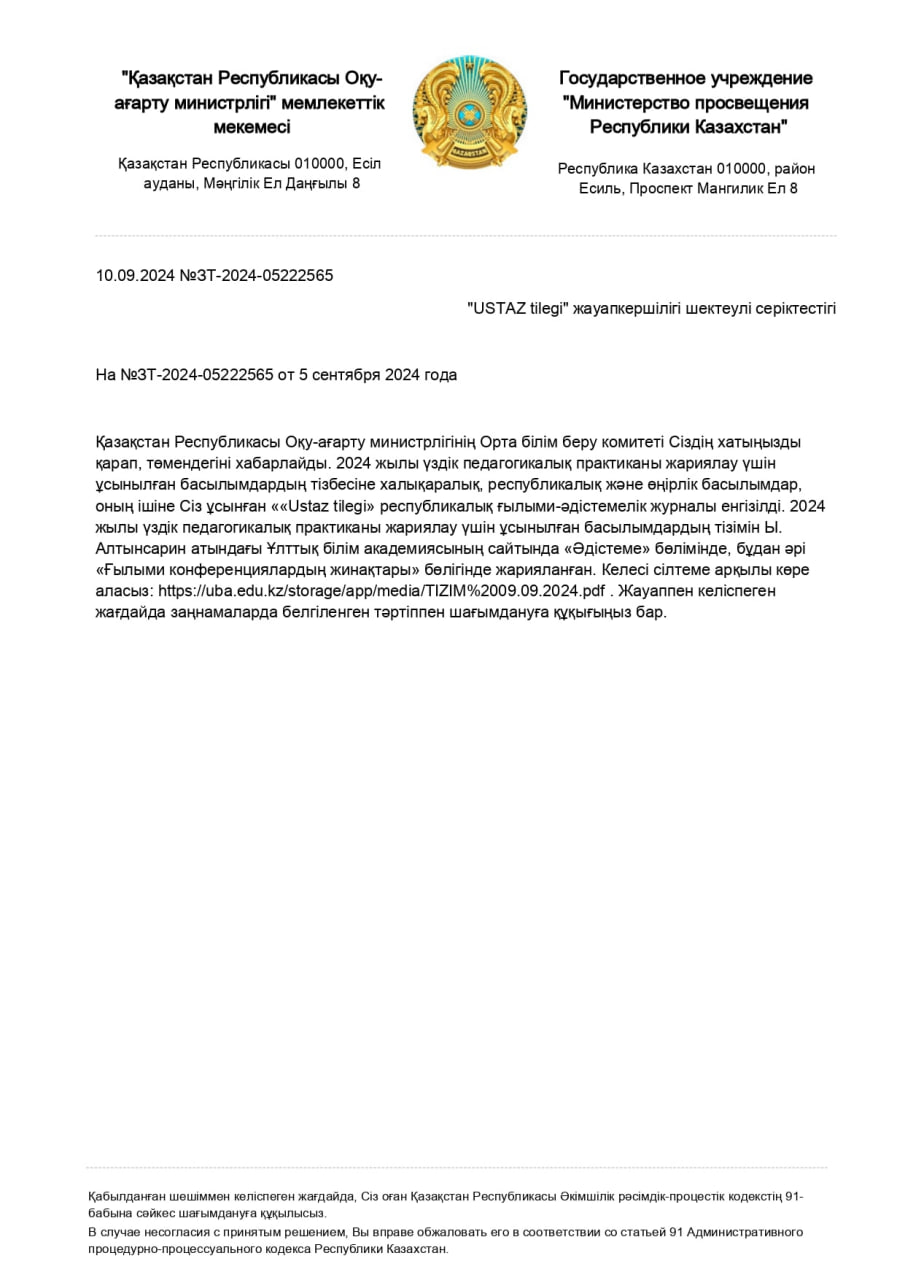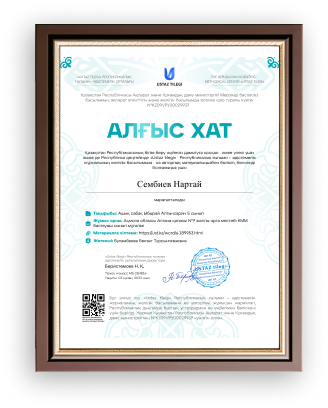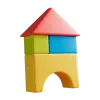
Қазақстан Республикасының Білім және ғылым
министрлігі
«Оқушылар
сарайы»МКҚК
Лингвистикалық бағыт айлығы
Theme: What do you eat for
breakfast?
Baimukhan Akbota
Nurlankyzy
Қысқа мерзімді (сабақ) жоспары
|
Бөлім: |
My life |
|
|
Педагогтің Т.А.Ә. (болған жағдайда) |
||
|
Күні: |
11.11.2024 |
|
|
Сынып: |
Қатысушылар саны: |
Қатыспағандар саны: |
|
Сабақтың тақырыбы |
What do you eat for breakfast? |
|
|
Оқу бағдарламасына сәйкес оқыту мақсаттары |
By the end of the lesson pupils will be able to use suffixes correctly. Eating the healthy and weightily foods for breakfast, (dinner, supper). |
|
|
Сабақтың мақсаты |
Educational: to introduce the children with new vocabulary on the topic “What do you have for breakfast” Developing: to develop the use of lexical, grammar materials in speech in two languages: Kazakh and English; to develop working in pairs, enrich the vocabulary of the pupils |
|
Сабақтың барысы
|
Сабақтың кезеңі/ уақыт |
Педагогтің әрекеті |
Оқушының әрекеті |
Бағалау |
Ресурстар |
|
1. Beginning (15 min) |
Hello, Good morning pupils!
How are you? Fine, thanks. Sit down. -Who is absent today? Checking- up of the home task Ok, very nice. What was your home task? Ok, let me to check up your copy books? Are you ready? |
Hello teacher Fine and you? All are present/ pupils are absent.Our home task was ex… Pupils -Yes, we are ready |
|
Cards, picture and presentation. |
|
2. Middle (90 min) |
Well, let’s start our lesson. The theme of the lesson for today is “Having meals, menu”. Today we’ll learn expressions and introduce with new words, work with text. You’ll enlarge your vocabulary. It’s very interesting theme, I think. -Ok, look at the blackboard. We have some new words connected with the new theme. a) teacher reads new words. weight[weit] cалмақ equal [i:kwәl] теңестіретін. bottle ['bɔtl]
- бутылка first course[fә:st kɔ:s] – бірінші тамақ main course[mein kɔ:s] –негізгі тамақ, ыстық; garnish (side dish)[ga:ni∫] - гарнир; snack[snæk] – жеңіл тамақ; b) teacher reads new words again. c) teacher asks them to read new words individually. d) copy out this words in their vocabulary. -Good, boys and girls now, we read a text and translate it. We talk about meals. -read the text. English meals. English people eat marmalade, scrambled eggs, bacon and cornflakes in the morning. They eat cornflakes with milk. They usually eat fish and chips, meat with potatoes, hamburgers for lunch. British and American boys and girls take pocked lunches in lunch boxes to school. They like oranges, apples, cheese, ham sandwiches, banana sandwiches, raisins, yoghurt and chocolate. English people drink tea with biscuits and they likes drink tea with chocolate. Englishmen have their dinner in the evening. Grammar practice: Present simple and present continuous What do you eat for breakfast? - I eat … for breakfast -I have… for breakfast |
Pupils write new words and listen to the teacher
Pupils repeat them in chorus
Pupils copy out new words in their vocabulary.
- I usually eat …for breakfast -I am eating …for breakfast |
Great job! |
|
|
3. End (15 min) |
Feedback So, boys and girls! Our lesson is over. Thank you very much. I am satisfied with you. You were clever, so hardly and bright all over the lesson. Now I want to evaluate you Our lesson is over! Good bye ! |
Good bye teacher! |
|
|
жүктеу мүмкіндігіне ие боласыз
Бұл материал сайт қолданушысы жариялаған. Материалдың ішінде жазылған барлық ақпаратқа жауапкершілікті жариялаған қолданушы жауап береді. Ұстаз тілегі тек ақпаратты таратуға қолдау көрсетеді. Егер материал сіздің авторлық құқығыңызды бұзған болса немесе басқа да себептермен сайттан өшіру керек деп ойласаңыз осында жазыңыз
Оқушылар сарайы
Оқушылар сарайы
Қазақстан Республикасының Білім және ғылым
министрлігі
«Оқушылар
сарайы»МКҚК
Лингвистикалық бағыт айлығы
Theme: What do you eat for
breakfast?
Baimukhan Akbota
Nurlankyzy
Қысқа мерзімді (сабақ) жоспары
|
Бөлім: |
My life |
|
|
Педагогтің Т.А.Ә. (болған жағдайда) |
||
|
Күні: |
11.11.2024 |
|
|
Сынып: |
Қатысушылар саны: |
Қатыспағандар саны: |
|
Сабақтың тақырыбы |
What do you eat for breakfast? |
|
|
Оқу бағдарламасына сәйкес оқыту мақсаттары |
By the end of the lesson pupils will be able to use suffixes correctly. Eating the healthy and weightily foods for breakfast, (dinner, supper). |
|
|
Сабақтың мақсаты |
Educational: to introduce the children with new vocabulary on the topic “What do you have for breakfast” Developing: to develop the use of lexical, grammar materials in speech in two languages: Kazakh and English; to develop working in pairs, enrich the vocabulary of the pupils |
|
Сабақтың барысы
|
Сабақтың кезеңі/ уақыт |
Педагогтің әрекеті |
Оқушының әрекеті |
Бағалау |
Ресурстар |
|
1. Beginning (15 min) |
Hello, Good morning pupils!
How are you? Fine, thanks. Sit down. -Who is absent today? Checking- up of the home task Ok, very nice. What was your home task? Ok, let me to check up your copy books? Are you ready? |
Hello teacher Fine and you? All are present/ pupils are absent.Our home task was ex… Pupils -Yes, we are ready |
|
Cards, picture and presentation. |
|
2. Middle (90 min) |
Well, let’s start our lesson. The theme of the lesson for today is “Having meals, menu”. Today we’ll learn expressions and introduce with new words, work with text. You’ll enlarge your vocabulary. It’s very interesting theme, I think. -Ok, look at the blackboard. We have some new words connected with the new theme. a) teacher reads new words. weight[weit] cалмақ equal [i:kwәl] теңестіретін. bottle ['bɔtl]
- бутылка first course[fә:st kɔ:s] – бірінші тамақ main course[mein kɔ:s] –негізгі тамақ, ыстық; garnish (side dish)[ga:ni∫] - гарнир; snack[snæk] – жеңіл тамақ; b) teacher reads new words again. c) teacher asks them to read new words individually. d) copy out this words in their vocabulary. -Good, boys and girls now, we read a text and translate it. We talk about meals. -read the text. English meals. English people eat marmalade, scrambled eggs, bacon and cornflakes in the morning. They eat cornflakes with milk. They usually eat fish and chips, meat with potatoes, hamburgers for lunch. British and American boys and girls take pocked lunches in lunch boxes to school. They like oranges, apples, cheese, ham sandwiches, banana sandwiches, raisins, yoghurt and chocolate. English people drink tea with biscuits and they likes drink tea with chocolate. Englishmen have their dinner in the evening. Grammar practice: Present simple and present continuous What do you eat for breakfast? - I eat … for breakfast -I have… for breakfast |
Pupils write new words and listen to the teacher
Pupils repeat them in chorus
Pupils copy out new words in their vocabulary.
- I usually eat …for breakfast -I am eating …for breakfast |
Great job! |
|
|
3. End (15 min) |
Feedback So, boys and girls! Our lesson is over. Thank you very much. I am satisfied with you. You were clever, so hardly and bright all over the lesson. Now I want to evaluate you Our lesson is over! Good bye ! |
Good bye teacher! |
|
|

шағым қалдыра аласыз















